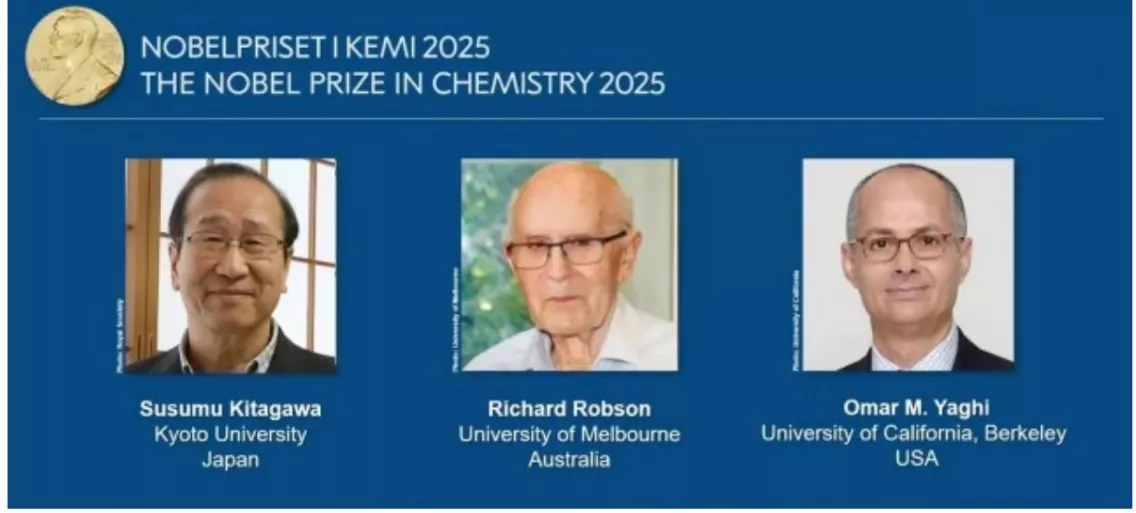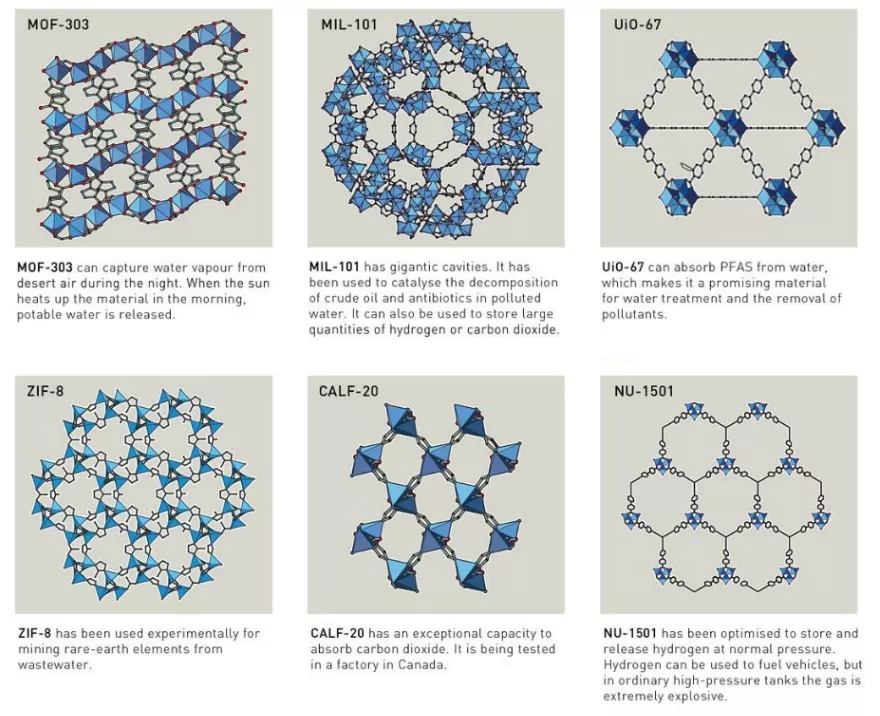The 2025 Nobel Prize in Chemistry has been awarded to Susumu Kitagawa, Richard Robson, and Omar Yaghi for pioneering Metal-Organic Frameworks (MOFs) — materials with uniquely designed porous structures that enable multiple scientific and industrial applications.

About Metal–Organic Frameworks (MOFs)
- Structure: MOFs are crystalline materials made by connecting metal ions (acting as nodes) with organic carbon-based linkers, forming three-dimensional networks with large cavities that allow gases or liquids to move in and out.
- Mechanism: Metal ions serve as anchors or joints, while organic molecules act as flexible linkers that can form rings or chains. This structure creates ordered pores that can be customised chemically and spatially.
- Functionality: These voids act like sponges or foams, capable of temporarily trapping and releasing other molecules such as gases or water.
- Analogy: The difference between normal compounds and MOFs is akin to a solid brick building versus one built of beams and pillars, where MOFs provide controlled empty spaces at the molecular level.

Development of MOFs
- Richard Robson’s Innovation (1970s): While teaching at the University of Melbourne, he envisioned linking metal atoms with molecules instead of other atoms to create expanded molecular structures. His early MOFs were unstable but conceptually groundbreaking.
- Further Advancement: Susumu Kitagawa (Japan) stabilised these frameworks and demonstrated that gases could pass through their cavities, proving their functionality.
- Omar Yaghi’s Breakthrough (1995): Yaghi’s (Jordan–USA) research in the US aimed to make chemical reactions predictable and controlled. His group created two-dimensional MOF structures bound by copper or cobalt, stable up to 350°C and capable of hosting “guest molecules.” He coined the term “metal–organic framework” in Nature (1995).
- Reticular Chemistry: Their creation laid the foundation for this new branch of chemistry, focusing on building extended frameworks using predictable linkages.
- Recognition: The Nobel Committee highlighted that chemists can now design tens of thousands of MOFs, enabling “new chemical wonders.”
| Reticular Chemistry: The science of linking molecular building blocks into extended crystalline frameworks through strong bonds. |
Distinctive Features
- Customisable Porosity: MOFs allow precise control over pore size, geometry, and chemical properties, unlike random pores in natural materials (e.g., sponge or bread).
- Design Flexibility: Chemists can pre-design MOFs to target specific molecules — defining what substances they capture, how much, and under what conditions.
- Environmental Relevance: Customisation of molecular spaces enables precise selection and capture of gases like CO₂, demonstrating their potential role in climate mitigation technologies.
- Chemical Stability: Some MOFs can withstand extreme heat and chemical conditions, enabling practical industrial applications.
Real-World Applications of MOFs
- Water Harvesting: MOFs can extract water from dry desert air, offering a sustainable solution for arid regions.
- Pollutant Removal: Capable of filtering contaminants like PFAS from water, aiding environmental cleanup.
- Carbon Capture: MOFs selectively trap CO₂ molecules, making them valuable in combating climate change.
- Hydrogen Storage: Their porous nature allows safe and efficient hydrogen storage, essential for green energy transitions.
- Food Preservation: MOFs can capture ethylene gas released by fruits, slowing ripening and reducing spoilage.
![]() 9 Oct 2025
9 Oct 2025




